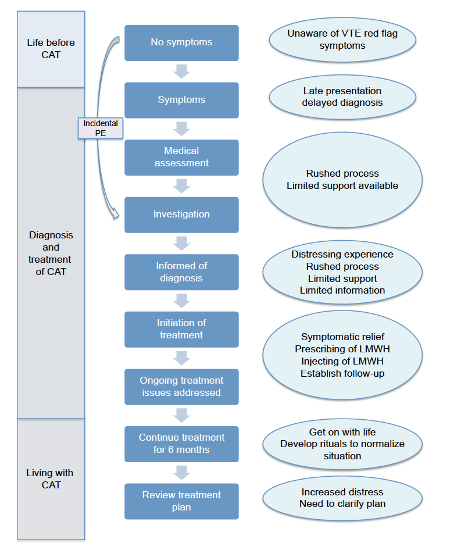The clinical issues and the main consequences of venous thromboembolism (VTE) in patients with cancer are nowadays well recognized and careful attention is paid to the treatment and to the assistance of such patients (1). Nevertheless, the real experience, feelings, and quality of life of patients diagnosed with VTE concomitantly or just after a diagnosis of cancer, have been neglected for a while. In this context, a qualitative research with the aim of understanding patient’s experience with VTE and cancer, the Patients’ Experience of Living with CANcer-associated thrombosis (PELICAN) study, has shown to be a reliable tool since its start, in 2013 (2). The first PELICAN study involved a set of patients from UK, which were subjected to semi-structured guided interviews, to assess the central issues experienced in their journey through cancer-associated thrombosis (CAT).

The results highlighted three critical stages in the progression of their experience with CAT that corresponded to
- Life before CAT
- Diagnosis and treatment of CAT
- Living with CAT (Figure 1, from Noble S et al, (2)).
Patients complained about the lack of basic information on CAT, such as its common occurrence on a cancer background and the main symptoms, they reported the initial shock reaction following the diagnosis and the adaptation to the new life with the adoption of a series of rituals concerning the heparin self-injections, which become part of their new life routine (2).
The positive experience of this study and the results, which allowed a better recognition of the physical, emotional and psychological experience of the subjects, encouraged the screening of other centers, to verify and compare the findings in different country’s healthcare system and culture, with the aim to assure a more patient-centric oriented treatment. In this light, the PELICANOS (3), PELICANADA (4), Le PELICAN (5) and PELICANZ (6) studies were carried out in Spain, Canada, France and New Zealand, respectively.
All these studies confirmed what established within UK patients, but also highlighted new prompts of discussion. In the PELICANOS study, for instance, the spouses of the enrolled patients were involved in the qualitative analysis, showing how the CAT experience influenced the family dynamic (3).
The PELICANDA experience confirmed the initial shock reaction to CAT diagnosis, the request of information and adaptive routine acquired by the patients. In addition, patients with pulmonary embolism were interviewed and the cost–effectiveness implications of the therapy emerged as further theme to be considered (4).
An interesting difference was shown by the results of Le PELICAN study in France, where the lack of information about CAT did not increase the patients’ distress. Moreover, the patients apparently showed a passive reaction to the decisions and communications of the clinicians with less interest to be actively involved in the therapy (5). The lack of basic information about CAT was described also within the patients from New Zealand, although with no specific anxiety or distress reported (6). One important issue to be considered is the standard of care used in the treatment of CAT, which was low-molecular-weight heparin along all the studies. The introduction of the use of oral anticoagulants may change the patients’ experience in the future.
The qualitative analysis of the PELICAN experience allowed to underline the need for a better patient information and for an improved coordination between cancer and CAT management, always with the final goal to assure a patient the best outcome.
References
- Key NS, Khorana AA, Kuderer NM, et al. Venous Thromboembolism Prophylaxis and Treatment in Patients With Cancer: ASCO Clinical Practice Guideline Update. J Clin Oncol. 2020 Feb 10;38(5):496-520. doi: 10.1200/JCO.19.01461.
- Noble S, Prout H, Nelson A. Patients’ Experiences of LIving with CANcer-associated thrombosis: the PELICAN study. Patient Prefer Adherence. 2015;9:337-345. doi:10.2147/PPA.S79373.
- Font C, Nelson A, Garcia-Fernandez T, Prout H, Gee P, Noble S. Patients’ Experience of Living with Cancer-associated thrombosis in Spain (PELICANOS). Support Care Cancer. 2018;26(9):3233-3239. doi:10.1007/s00520-018-4174-5.
- Noble S, Nelson A, Scott J, et al. Patient Experience of Living With Cancer-Associated Thrombosis in Canada (PELICANADA). Res Pract Thromb Haemost. 2019;4(1):154-160. doi:10.1002/rth2.12274.
- Mahé I, Chidiac J, Pinson M, et al. Patients experience of living with cancer associated thrombosis in France (Le PELICAN). Thromb Res. 2020;194:66-71. doi:10.1016/j.thromres.2020.06.024.
- Woulfe T, Mann K, Pollack D, Swarnkar P, Nelson A, Noble S. “Wolverine, I think it’s called: Blood thinners but in tablets.” Patients experience of living with cancer associated thrombosis in New Zealand (PELICANZ). Thromb Res. 2020;189:35-38. doi:10.1016/j.thromres.2020.02.024.
